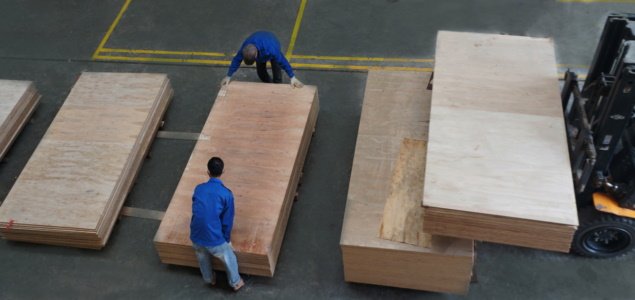The availability of natural legal wood is diminishing, posing a challenge for both domestic enterprises and traditional craft villages. It is essential for them to explore legal sources of wood that offer a stable and sustainable supply.
During the seminar titled “Fostering Collaboration between Companies and Households in Woodcraft Villages, Mitigating Risks, and Driving Sustainable Development in the Future Domestic Market,” Mr. Do Xuan Lap, the President of the Vietnam Timber and Forest Product Association (Viforest), emphasized that when discussing the wood industry, most individuals associate it with the remarkable export value of 15.87 billion USD achieved in 2021.
However, the wood industry is still grappling with the challenge of ensuring a legal wood supply, according to Mr. Lap. Vietnam imports approximately 4-5 million cubic meters of raw wood annually, but 30–40% of this falls into the high-risk category. This situation can lead to repercussions, as evidenced by the U.S. Trade Representative’s Section 301 investigation into Vietnam’s wood industry at the end of 2020.
Another issue highlighted by the president of Viforest is the complex global landscape. Therefore, the domestic market, with its nearly 100 million population and a significant middle-class segment, is an “integral part that cannot be separated.” It aids the wood industry in standing firm, sustaining operations, and exploring new customer segments.
“Most of the high-risk imported wood is processed into wooden products and supplied to the domestic market through a network of over 300 woodcraft villages, primarily concentrated in the provinces of the Northern Delta, involving tens of thousands and even hundreds of thousands of participating households,” stated Mr. Lap.
.jpg)
To elaborate further on Mr. Do Xuan Lap’s perspective, To Xuan Phuc, an expert from the organization Forest Trends, shared that traditional woodcraft villages are currently undergoing a period of significant changes.
Specifically, the workforce in these craft villages is experiencing aging, as younger individuals are opting to work in industrial zones for stable incomes. Additionally, a decrease in demand from certain traditional markets like China compels the craft villages to pay more attention to the domestic market.
These changes result in a shift across all three customer segments of these craft villages. Previously, the supply for the low segment primarily came from plantation wood; the middle segment (targeting the younger, urban demographic) relied on low-risk imported wood; and the high-end segment focused on natural wood, mostly imported, catering to the middle-aged, higher-income group.
“Customers are now more concerned about quality and design. An elderly individual might also prefer Western wood products (low-risk imported wood) if the product offers suitable values,” stated Mr. Phuc.
A Forest Trends expert evaluates that craft villages in Vietnam have strengths in high craftsmanship, an existing production system, and a long-standing tradition. However, the weaknesses lie in spontaneous, decentralized, small-scale production, simple technology, limited design changes, and constrained management. This leads to the risk of dependence on a few markets and difficulty keeping up with consumer trend shifts.
Emphasizing the increasing scarcity of “precious wood and natural wood,” Mr. To Xuan Phuc advises woodcraft villages such as La Xuyen, Dong Ky, Lien Ha, Huu Bang, etc., to pay attention to signals from the international market. In the short term, it involves connecting various craft villages and linking these villages with businesses that supply legal wood.

During the seminar, Mr. Va Quang Ha, Chairman of Tan Vinh Cuu Joint Stock Company (Tavico), shared the idea of establishing an ecosystem for traditional woodcraft villages. In this ecosystem, the company would ensure the supply of foreign wood (Western wood) through a central market in the Ho Nai area, Bien Hoa City, Dong Nai Province. The products would be provided to the craft villages in the form of “semi-finished” goods.
In parallel with that, Tavico is also constructing a space for craft villages and cooperatives to exchange ideas, share knowledge, and showcase sample products. “When wood businesses and craft villages concentrate their intellect, leveraging the experience of businesses and the essence of craft villages, it will create a space for creativity and freshness for Vietnam’s wood brand and products,” expressed Mr. Ha.
Supporting Mr. Ha’s idea, Chairman of Viforest, Mr. Do Xuan Lap, acknowledges the limited collaboration between craft villages and companies in the wood industry. In other words, the craft villages exist relatively independently but have yet to become an integral part of the supply chain.
“Some collaborative models, such as the one Tavico is building with several craft villages in the north, serve as bright spots. We need to spread these values before waiting for the state’s mechanisms and support policies,” emphasized Mr. Lap.
The Vietnamese government has made strong commitments to eliminate illegal wood from the supply chain. Reducing the volume of high-risk imported wood contributes to promoting the demand for plantation wood and, at the same time, changing habits regarding the use of natural wood.
Mr. Nguyen Van Truong, representing the woodworking craft village of Thuy Lan in Yen My district, Hung Yen province, noted that in the past, his village predominantly used woods like iron-wood, mahogany, and santai for production, aligning with the Vietnamese preference for durable products. However, facing the recent scarcity of natural woods, the craft village has undergone a shift, actively seeking new sources. Mr. Truong emphasized the village’s interest in collaborating with legal, stable, and sustainable wood suppliers, aiming to minimize market analysis costs and facilitate trade and logistics while promoting their products.
Source: goviet.org.vn




